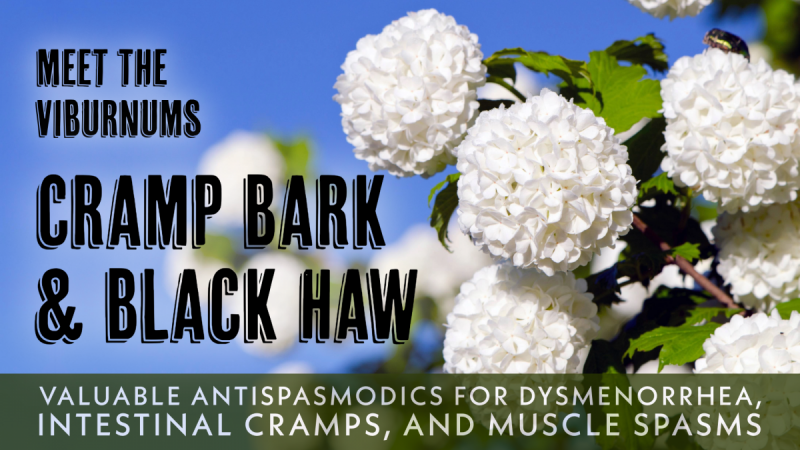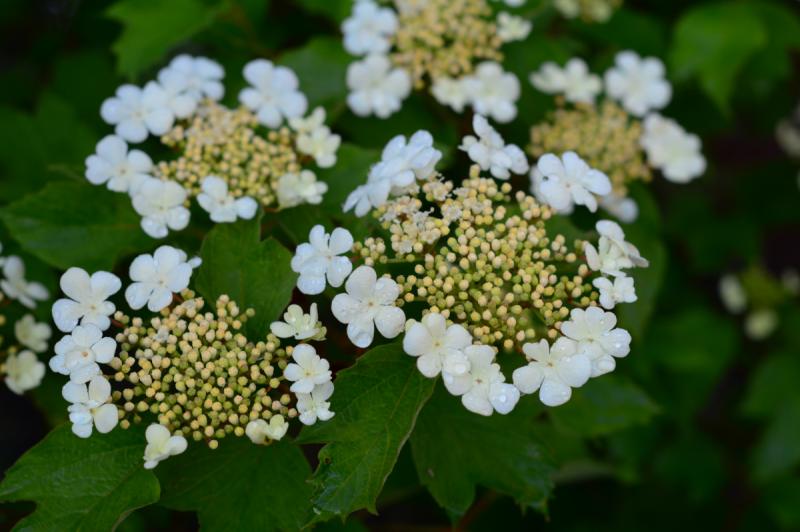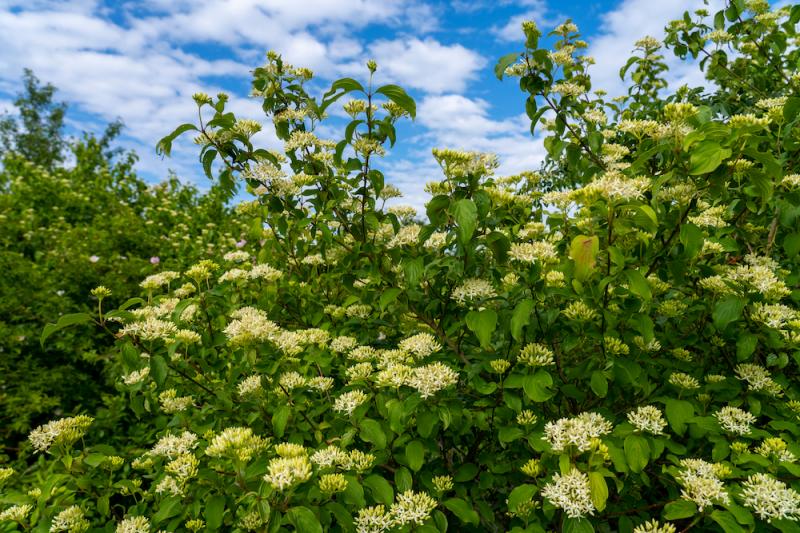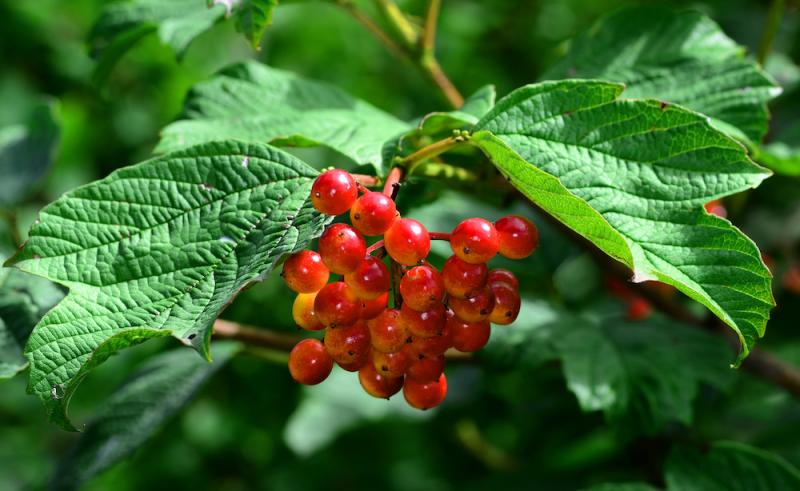
I have a lot of fond memories of snowball bushes. Growing up, there was one in front of one of my friend's homes and I remember one day we tried to have a summertime snowball fight by picking the round inflorescences and throwing them at each other. They didn’t break apart like real snowballs, so we could throw them again, but they didn’t travel very far and you really couldn’t feel them when they hit you, so we gave up. Thinking about this also triggered memories of my daring attempt to establish the Do-Good Patrol.
And even though I was studying edible and medicinal wild plants at the time I didn’t know that these bushes had medicinal value until I was an adult. In fact I was mistaken in believing that the berries were poisonous.
While I enjoy the name snowball bush, the shrubs are also known as Guelder rose or cramp bark and are scientifically classified as Viburnum opulus. The shrub is native to Europe, but there is an American species, Viburnum trilobium (or V. prunifolium), which is known as black haw. Black haw was used by Native American tribes for similar purposes. Cramp bark appears to be a stronger antispasmodic. Matthew Wood says it’s more acrid, while black haw is more sour, which makes it more cooling or anti-inflammatory. However, despite these differences, both are indicated for tension (cramps and spasms) and inflammation.
Female Remedy
 Both viburnums have long been used to treat dysmenorrhea or painful menstruation. Cramp bark is especially indicated with sharp cramping pains. Matthew Wood recommends it for painful menstruation in younger women and black haw for painful menstruation in older women. It’s also been used during childbirth to ease labor pain and afterbirth pain. It has a relaxing effect on the uterus and has also been used to help stop miscarriage in early pregnancy. I’ve never used it for this purpose, but I have used lobelia along with false unicorn, so I think it could be used as an alternative to the lobelia.
Both viburnums have long been used to treat dysmenorrhea or painful menstruation. Cramp bark is especially indicated with sharp cramping pains. Matthew Wood recommends it for painful menstruation in younger women and black haw for painful menstruation in older women. It’s also been used during childbirth to ease labor pain and afterbirth pain. It has a relaxing effect on the uterus and has also been used to help stop miscarriage in early pregnancy. I’ve never used it for this purpose, but I have used lobelia along with false unicorn, so I think it could be used as an alternative to the lobelia.
Other Uses for Viburnums
 The viburnums have also been used to treat problems in the gastrointestinal tract. This includes painful intestinal cramps, excess mucus in the digestive system, adult colic, and nervous indigestion. It can also reduce intestinal inflammation in colitis. I assume black haw would be the better choice in these cases because it’s more cooling.
The viburnums have also been used to treat problems in the gastrointestinal tract. This includes painful intestinal cramps, excess mucus in the digestive system, adult colic, and nervous indigestion. It can also reduce intestinal inflammation in colitis. I assume black haw would be the better choice in these cases because it’s more cooling.
The fact is, that both viburnums, like other antispasmodics, are helpful for spasms and tension anywhere in the system. They can ease spasms in the lungs associated with asthma or spastic cough. They can relax the urinary passages to ease difficult urination and possibly aid the passing of kidney stones.
Cramps in the structural system may also respond to this remedy. These include back pain brought on my muscle tension, neck pain, lockjaw, and other problems associated with cramps and tension. They may also help lower blood pressure and help with heart palpitations.
High Bush Cranberries
 The berries of viburnum have been called high-bush cranberry. They aren’t cranberries of course, and they’re not even berries. The fruit is a drupe, the same form of fruit as a cherry or apricot. I’ve never tried eating them, but I understand they’re not very palatable being very tart and somewhat astringent. They are highly antioxidant and probably anti-inflammatory as well, so it might be better to think of them as a medicinal food. You can sweeten them and use them for jelly or pie. The astringency comes mostly from the seeds, which should be removed before cooking them.
The berries of viburnum have been called high-bush cranberry. They aren’t cranberries of course, and they’re not even berries. The fruit is a drupe, the same form of fruit as a cherry or apricot. I’ve never tried eating them, but I understand they’re not very palatable being very tart and somewhat astringent. They are highly antioxidant and probably anti-inflammatory as well, so it might be better to think of them as a medicinal food. You can sweeten them and use them for jelly or pie. The astringency comes mostly from the seeds, which should be removed before cooking them.
Using Cramp Bark and Black Haw
Both cramp bark and black haw are common ingredients in formulas to ease menstrual problems in women and that’s probably one of the best ways to use them. If you plan to use them as a single remedy, a tincture is probably the best form because it’s easier to regulate the dose. You simply keep taking small amounts until the cramps and pain cease. Matthew Wood suggests a tincture made from the fresh bark is best. I’d do a 1:5 tincture in 50% alcohol.
It’s also likely that other species of Viburnums can be used as food or medicine. Native American Ethnobotany book by Daniel E. Moerman lists six other species used by native Americans for food and/or medicine—Viburnum acerifolium, V. dentatum, V. edula, V. lantanoides, V. lentago, and V. nudum. Since the plants are not poisonous you might want to experiment with other species if they grow in your area.
Steven's Articles
-

-
The Evidence for Berberine
A yellow alkaloid found in traditional infection-fighting…
-

-
The Sensible Use of Caffeinated Herbs
Kola nuts, guarana, and yerba mate and other herbs…
-

-
The Health Benefits and Problems with Coffee
This popular caffeinated beverage can be beneficial…
October
-

-
Understanding Caffeine & Cellular Adaptation
Preserving the power of caffeine's buzz and the…
September
-

-
Horseradish
A pungent spice for aiding protein metabolism…
-

-
Banaba or Crepe Myrtle
A beautiful tree from Southeast Asia whose leaves…
August
-

-
Monkeyflowers
Flower essences to help see ourselves more clearly…
-

-
Mariposa Lilies
Strengthening the bond between mother and child…
-

-
The Noble Bay Leaf
A common kitchen herb for aiding digestion and…
-

-
Epimedium: Horny Goat Weed
A circulatory stimulant and kidney yang tonic…
July
-

-
The Medicinal and Nutritional Benefits of Apricots
A nutritious fruit and valuable medicinal seed for coughs
-

-
Dogwoods
Asian dogwood is used to stop excessive discharge,…
June
-

-
Neem: The Village Pharmacy
A popular Ayurvedic remedy for dental and immune…
-

-
Spilanthes: The Toothache Plant
A traditional remedy for teeth and gums, as well…
-

-
Forsythia
An anti-inflammatory, fever-reducing, and infection fighting herb

